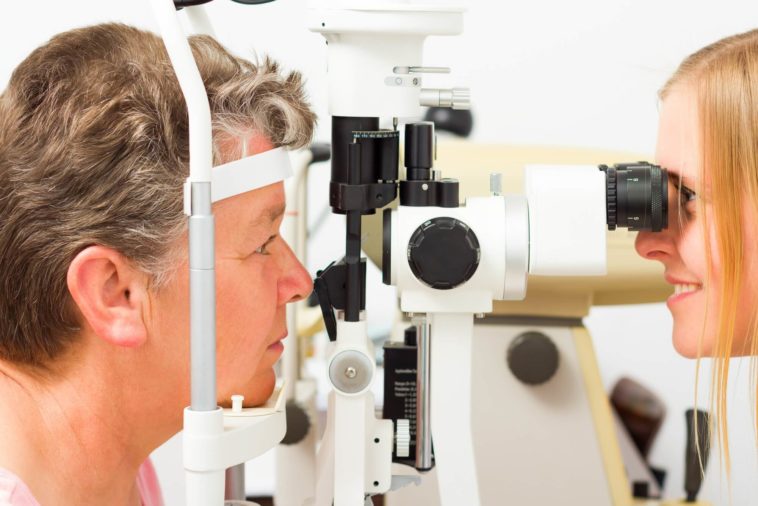What are Cataracts?
Cataracts are a condition that occurs when the lens of the eye becomes clouded, causing vision loss. The lens is a clear structure behind the iris that helps to focus light onto the retina. In a healthy eye, the lens is transparent, allowing light to pass through and be focused onto the retina. When a person has cataracts, the lens becomes cloudy, which can cause vision to become blurry or hazy.
Cataracts are a common condition that typically occurs in older people. Still, they can also occur in younger people due to certain medical conditions or an injury.
Types of Cataracts
There are several different types of cataracts, including:
- Nuclear cataracts: are the most common type and occur when the center of the lens (the nucleus) becomes cloudy. They typically develop gradually over time and can cause vision to become blurry or yellowed.
- Cortical cataracts: Cortical cataracts occur when the outer part of the lens (the cortex) becomes cloudy. They can cause vision to appear white or cloudy, and they may cause glare or halos around lights.
- Posterior subcapsular cataracts are a cloud that develops at the back of the lens. It can cause blurry or distorted vision and create glare and halos around lights. Patients with this type of cataract may experience difficulty focusing on objects, decreased night vision, and problems reading small print.
- Congenital cataracts: are a type of eye condition that describes when someone is born with or develops shortly after birth, a clouding in the eye’s lens. These types of cataracts can be caused by genetic factors or triggered by certain infections or illnesses during pregnancy. Being born with or developing shortly after birth, cataracts can cause vision loss and developmental delays in children.
Cataracts are most common in older adults but can happen to people of any age. They usually occur in both eyes, although not always simultaneously. Cataract treatment usually requires surgery to remove this cloudy lens and replace it with an artificial one called an intraocular lens (IOL). This surgery is typically performed by an ophthalmologist, a doctor specializing in diagnosing and treating eye conditions.
Cataracts Causes
Cataracts are caused by changes in the proteins in the eye’s lens. These changes can cause the lens to become cloudy or opaque, disrupting the normal flow of light through the eye and causing vision problems.
The risk of developing cataracts can be increased by a variety of factors, such as:
- Age: Cataracts are more common in older adults, and the risk of developing cataracts increases with age.
- Exposure to UV radiation can significantly increase your chances of getting cataracts, which can severely diminish your vision if left untreated.
- Diabetes: People who have diabetes are more likely to develop cataracts.
- Smoking: Smoking tobacco products can increase the risk of developing cataracts.
- Alcohol consumption: Heavy alcohol consumption can increase the risk of developing cataracts.
- Certain medications: Some medications, such as corticosteroids, can increase the risk of developing cataracts.
- Genetic factors: Cataracts can sometimes be inherited, and certain genetic factors may increase the risk of developing cataracts.
If you are at risk or experiencing vision problems, you must speak to your eye doctor about treatment options for cataracts.
Diagnosing and Treatment of Cataracts
Cataracts are a common eye disease that can cause vision loss as we age. They occur when the eye’s natural lens becomes cloudy or opaque, making it difficult to see.
If you are experiencing vision problems, seeing an eye doctor for a comprehensive eye exam is vital to determine if you have cataracts and what treatment options are available.
To diagnose cataracts, an eye doctor will examine the structures of your eye and test your vision. They may also use special tools, such as a microscope, to get a closer look at the lens. They may also use a special dye to highlight any abnormalities in the lens.
If cataracts are present, treatment options will be discussed with you. The primary treatment option to address cataracts is surgery, in which doctors remove the cloudy lens and replace it with an intraocular lens, an artificial lens. An ophthalmologist typically performs this surgery.
Cataract surgery is generally considered safe and effective and can significantly improve vision in people with cataracts. Several different types of cataract surgery are available, including traditional cataract surgery, laser-assisted cataract surgery, and premium IOLs. Your eye care professional will discuss the various options and help determine which surgery is best for you.
After cataract surgery, it is vital to follow the instructions of your eye care professional and take any prescribed medications as directed. You may need eye drops or ointments to help heal and prevent infection. You may also need to wear eyeglasses to protect your eye while it heals. It is vital to keep all follow-up appointments with your eye care professional to ensure that your eye is healing properly and that your vision is improving.
If you are experiencing vision problems, seeing an ophthalmologist for a comprehensive eye exam is essential. Early detection and treatment of cataracts can help to preserve your vision and improve your quality of life.
Lumineyes: Cataract Surgery Options
Lumineyes is a brand of intraocular lens (IOL) used in cataract surgery. IOLs are artificial lenses that replace the cloudy natural lens during cataract surgery. Lumineyes IOLs are designed to provide improved vision in various lighting conditions and reduce the need for glasses or contacts after surgery.
There are several different types of Lumineyes IOLs available, including:
- Lumineyes Mplus: This IOL is designed to provide improved vision at all distances, including near, intermediate, and far. It is suitable for people with a wide range of vision needs.
- Lumineyes Mplus X: This IOL is similar to the Lumineyes Mplus but is designed to provide even better vision at all distances, especially in low-light conditions.
- Lumineyes Mplus XR: This IOL is designed to provide the best possible vision at all distances, including near, intermediate, and far. It suits people with more advanced cataracts and those with higher visual demands.
Lumineyes IOLs are made from a particular material called hydrophobic acrylic, resistant to moisture and protein deposits. This helps to reduce the risk of complications after surgery and improves the long-term stability of the lens.
Before deciding on a Lumineyes IOL, discussing your options with your eye doctor and considering your individual vision needs is essential, they can help you determine which type of Lumineyes IOL is best for you and whether it fits your lifestyle and visual demands.
Different Types of Cataract Surgery
There are several different types of cataract surgery available, including:
- Traditional cataract surgery: This is the most common type of cataract surgery. It involves making an incision in the eye and manually removing the cloudy lens. The incision is usually made on the side of the cornea. An artificial lens, an intraocular lens, is inserted to replace the cloudy natural lens.
- Laser-assisted cataract surgery: This type of cataract surgery uses a laser to help with some surgery steps. The laser can be used to make the incision in the cornea, soften the cloudy lens, and assist with removing the lens. Laser-assisted cataract surgery may be more accurate and precise than traditional surgery, but it may only be available at some medical centers.
- Premium IOLs: Premium IOLs are specialized artificial lenses that can improve vision in certain situations. They can be used in place of traditional IOLs during cataract surgery. Several premium IOLs available, including multifocal IOLs, toric IOLs, and accommodative IOLs. Multifocal IOLs can provide improved vision at multiple distances. In contrast, toric IOLs can correct for astigmatism (a condition in which the eye is shaped more like an oval than a sphere). Accommodative IOLs can change shape to focus on objects at different distances.
When it comes to cataracts, there are multiple viable treatments. Your doctor can help you decide which is suitable for you, depending on your unique circumstances and visual requirements. It’s essential to have an open dialogue with an eye specialist to understand and weigh the pros and cons of possible procedures and keep in mind your lifestyle and desired vision outcomes.
After Cataract Surgery Care
After having cataract surgery, it is essential to adhere to your eye doctor’s instructions and take any prescribed medications as directed. You may need eye drops or ointments to heal correctly and protect against infections. Additionally, it would help if you considered wearing protective eyeglasses to shield your eye from irritation further while it heals.
Here are some tips for after-surgery care for cataracts:
- Keep your follow-up appointments: It is essential to keep them with your eye care professional to ensure that your eye is healing correctly and your vision is improving. They may need to adjust your medications or your treatment plan as needed.
- Take care of your eye: Avoid rubbing or touching your eye, and avoid getting water or soap while showering or washing your face. You should also avoid wearing eye makeup or swimming for at least a week after surgery.
- Protect your eye from injury: Be careful not to bump or hit your eye, and avoid activities that could cause eye injuries, such as contact sports or heavy lifting.
- Wear sunglasses: Protect your eye from bright light and glare outside.
- Use eye drops as directed: If you have been prescribed eye drops, use them as directed. This will help to keep your eye moist and prevent infection.
- Avoid driving: Only drive once your eye doctor says it is safe. This is usually after your first follow-up appointment, typically a few days after surgery.
By following these tips, you can help to ensure a successful recovery after cataract surgery and improve your vision.
Cataract Surgery Complications
Cataract surgery is generally considered safe and effective and can significantly improve vision in people with cataracts. In most cases, cataract surgery improves vision and significantly reduces the need for glasses or contacts.
Some potential complications of cataract surgery include:
- Infection: There is a small risk of infection after cataract surgery. This can be treated with antibiotics.
- Bleeding: Bleeding during or after surgery is rare but can occur.
- Swelling: Swelling of the eye or surrounding tissues can occur after surgery, but it usually resolves independently.
- Posterior capsule opacification: This condition is where the back of the lens capsule (the clear outer layer surrounding the artificial lens) becomes cloudy. It can cause vision to become blurry or distorted and may require additional treatment.
- Retinal detachment: In rare cases, the retina can become detached after cataract surgery. This can cause vision loss and requires immediate medical attention.
- Lens dislocation: The artificial lens (intraocular lens, or IOL) placed during cataract surgery can become dislocated or move out of position. This can cause vision problems and may require additional surgery to reposition the lens.
Cataracts can lead to significant eye complications if they develop and are not adequately treated. With prompt and appropriate treatment, most cataract complications can be addressed successfully. To have successful cataract surgery, following your ophthalmologist’s instructions is of the utmost importance; any potential issues or concerns during the post-surgery period should be reported to the eye doctor quickly.
Cataract Surgery: The Strong Points
Cataract surgery has several benefits, including:
- Improved vision: Cataract surgery is designed to improve vision in people who suffer from cataracts. The procedure typically results in immediate improvement, with even more enhancement in the weeks following–as your eye continues to heal.
- Reduced need for eyeglasses: Patients with cataract surgery may experience improved eyesight and a decreased need for glasses or contacts. This can be seen in many cases where individuals no longer require glasses to see clearly, though they may still need them for specific tasks, such as reading or driving at night.
- Remedy for improved vision: Cataracts, which happen when the lens of the eye clouds over, can be remedied through surgery. These surgeries often result in improved vision and increased independence for people who suffer from cataracts as they can allow them to do everyday activities like driving, reading, or participating in hobbies or activities that they may not have been able to do before.
- Cataract surgery can help improve the quality of life for many individuals by restoring their vision and allowing them to do more of the activities they enjoy.
- Cataract surgery offers a range of benefits, especially for older adults. It is well known that poor vision can be a significant contributing factor to falls. Still, cataract removal through surgery can help to improve vision and therefore decrease the risk of falls.
- Cataract surgery is a safe and effective way to treat cataracts and restore vision. Most people who undergo the procedure have few side effects and enjoy improved eyesight afterward.
If you are experiencing vision problems due to cataracts, you must see an eye care professional for a comprehensive eye exam. They can determine if cataract surgery is an option for you and discuss its benefits and risks.






